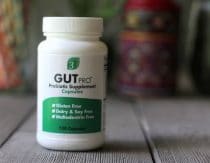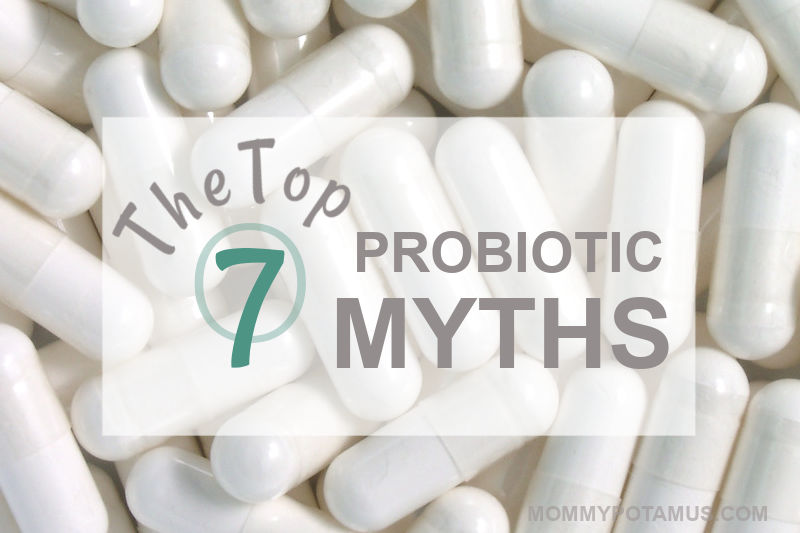
Have you ever stood in the aisle of a health food store and considered the eeny-meeny miny moe approach to choosing a probiotic?
It’s no secret that they have profound health benefits, but there are a lot of myths that can make finding a good one downright confusing.
In this article we’ll look at the top seven misconceptions, what the research actually says, and what to look for in a probiotic.
Before we dive into the details, though, I want to mention that none of these statements have been evaluated by the FDA, this article is not medical advice, and it is not meant to diagnose or treat any condition. As always, please talk with your healthcare provider about any supplements you are considering. Now that we’ve got that out of the way, let’s take a look at the myths.
- Myth #1: Strain Specificity Doesn’t Matter
- Myth #2 – More Is Always Better
- Myth #3 – Probiotics Only Benefit Digestive Health
- Myth #4 – Probiotics Must Colonize (aka Stick Around) The Digestive Tract To Work
- Myth #5 – All Probiotics Need To Be Refrigerated To Stay Alive
- Myth #6 – You can’t use probiotics during an antibiotic treatment
- Myth #7 – Benefits Are Always Noticeable Right Away
- What To Look For In A Probiotic Supplement
- Which Probiotic I Use (And Why)
- Want to try Seed’s Daily Synbiotic?
Myth #1: Strain Specificity Doesn’t Matter ^
Flip a probiotic supplement over to look at the label, and you’ll often see “lactobacillus rhamnosus, “bifidobacterium bifidum,” or something similar. Both of those examples tells you the genus and species, but not the specific strain . . . and that’s important, because strain absolutely matters.
To understand why, let’s take a look at E. coli:
- E. coli 0157: NH can cause serious illness and is the reason for many of the food recalls we often hear about (lettuce, cheese, meats, etc.)
- Another strain – Nissle 1917 – is used therapeutically for gastrointestinal issues
Same genus, very different strains and effects.
Although 99% of the bacteria on earth are either harmless or helpful, even closely related strains don’t necessarily have the same benefits, so it’s important to choose ones that have specifically studied in human trials. (1)
Beyond that, it’s important to remember that even clinically studied strains are not identical in their effects. Some support oral health while others support the immune system, skin health, and more. So in addition to using clinically studied strains of bacteria, it’s important to consider your goals when selecting which one to go with.
Because I don’t have a specific goal other than to support my microbiome, I use a probiotic that includes twenty-four research-backed strains that support:
- Digestive Health, Gastrointestinal Immunity & Gut Barrier Integrity
- Dermatological Health
- Cardiovascular Health
- Micronutrient Synthesis
If you want to try it out, click here and use MPSAVE15 for 15% off your first month.

Myth #2 – More Is Always Better ^
Probiotic supplement bottles often say something like “30 billion CFU” in big, bold letters on the front. CFU stands for colony forming units and describes how many living microorganisms are found in each serving, so it seems like it would be a good indicator of potency and therapeutic effectiveness.
More is not necessarily better, though. What really matters is how much of the bacteria will actually make it into your gut alive and whether or not the dosage is likely to have a beneficial effect.
Let’s take water as an example: There’s a sweet spot of optimal intake – too little and we feel dehydrated, a little too much and we feel uncomfortable and bloated.
It’s kind of like that with probiotics, so here’s what to look for instead of just a big number:
Probiotics that have a high degree of survivability, which is the technical term for how many organisms actually make it to the digestive tract alive after going through our stomach acid. Survivability can vary a lot based on the strain and the way it is encapsulated.
Probiotics that use a therapeutic potency range, or the number of CFUs that have been found in human clinical trials to be the most helpful. You definitely want a high enough CFU to match what’s been shown to be beneficial, but several studies have concluded that going far above that range doesn’t usually create any additional benefit and just makes the product more expensive.
In the future you’ll probably see more probiotics labeled with AFUs (Active Fluorescent Units) alongside or instead of CFUs. AFU is a more accurate way to measure potency, but because most clinical studies have used CFUs they’re usually what you’ll find on product labels.
Myth #3 – Probiotics Only Benefit Digestive Health ^
While it’s true that probiotics can positively impact our gut health – and that’s no small thing given that in one study 61% of Americans reported experiencing diarrhea, gas, bloating, stomach pain, or infrequent bowel movements related to poor digestion – they can have powerful effects on the whole body, too.
Probiotics directly interact with our immune system, make vitamins and other beneficial compounds for us, and support skin, heart and urinary tract health to name a few benefits – you can read more about the health benefits here.
Myth #4 – Probiotics Must Colonize (aka Stick Around) The Digestive Tract To Work ^
When we talk about probiotics we often use the phrase “restore the gut,” which basically refers to consuming good bacteria in hopes that they will colonize the gut. Research doesn’t support the idea that probiotic supplements stick around long-term, though . . . or even that they need to in order to benefit us.
Our gut microbiome is constantly changing, and it’s strongly influenced by how much fiber we eat, stress levels, how well we’re sleeping, and other factors. Though we do tend to have strains that stick with us over time, many beneficial microbes are more like skilled workers that are just passing through town, doing important work before they head on their way.
So just like we can’t “eat healthy” for one day and expect it to cover our nutritional bases for the other 364 days in a year, probiotics need to be taken consistently in order to deliver the best results.
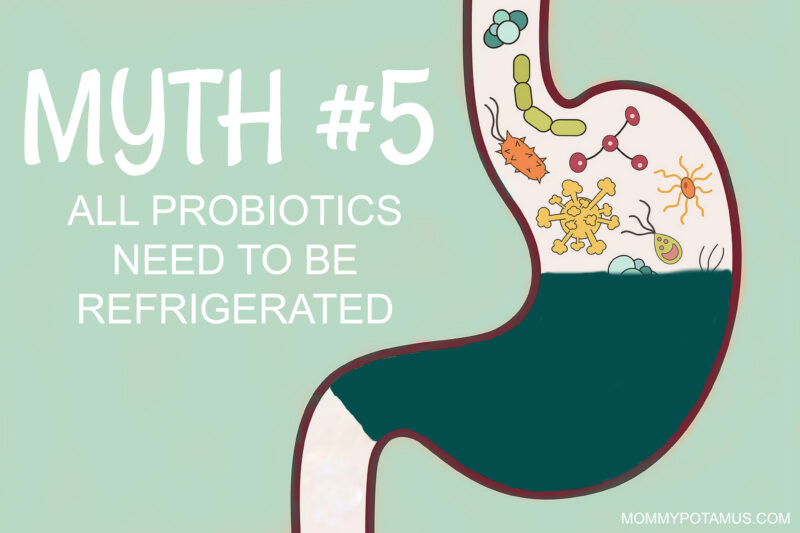
Myth #5 – All Probiotics Need To Be Refrigerated To Stay Alive ^
I used to make a beeline for the refrigerated probiotics at my local health food store because I didn’t trust the ones on the regular shelves. After all, if probiotics are sensitive to heat, what was the chance that those probiotics were even still alive?
While it’s true that probiotics need to be protected from excess heat, light and moisture – especially during transport – it’s important not to discount probiotic products that don’t require refrigeration.
Thanks to a process called lyophilization (freeze-drying), probiotic makers can now render probiotics dormant, meaning that they stay in an inert, shelf-stable state until they’re reactivated in the digestive tract.
Though they’re still vulnerable to extreme temperatures, freeze-dried probiotics are fine at room temperature and may actually be better than non-dormant, live bacteria in at least one way: shelf life. In general, live cultures tend to have a shorter shelf life than probiotics that are stored in a dormant state and then reactivated.
Myth #6 – You can’t use probiotics during an antibiotic treatment ^
For a long time we thought of taking probiotic alongside antibiotics as a waste of money because they’d be killed by the medication, but new research suggests that may not always be the case.
It’s true that antibiotics affect the populations of friendly bacteria that live in our gut and may result in digestive discomfort such as diarrhea as the good guys are killed. However, though antibiotics don’t discriminate between good and bad bacteria, some probiotic strains seem to be hardy enough to reach the gut alive, even when taken during a course of antibiotics.
Two in particular that have been studied are Lactobacillus rhamnosus Rosell-11 and Lactobacillus acidophilus Rosell-52. (2)(3)
With that said, one very small study has brought a bit of controversy to this approach. It found that eight individuals who took probiotics after antibiotics recovered more slowly than those who took nothing at all. (4)
However, a large-scale meta-analysis of 63 other research trials found that probiotics helped reduce at least one of the negative effects of taking antibiotics (digestive distress/loose stools). (5)
In general, it’s recommended that probiotics and antibiotics be taken at least two hours apart from each other. (6)
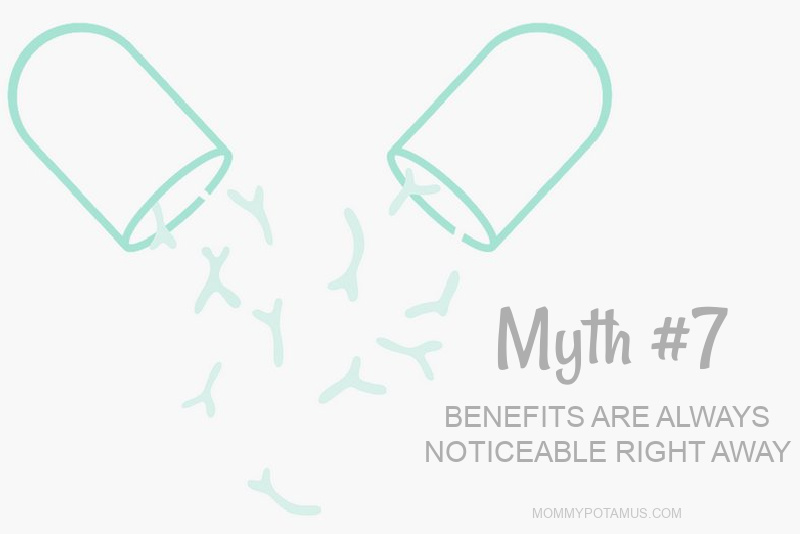
Myth #7 – Benefits Are Always Noticeable Right Away ^
I recently posted an article about the probiotic I use (which I’ll cover below), and I got a question that said something like, “I just started probiotics three days ago and I feel absolutely no change at all – is this normal?”
Bottom line: Yes.
While some people notice actually improvement in as little as two days, researchers have also documented benefits at four weeks, twelve weeks, and beyond. (7)(8)(9)
A lot of factors including the microbe strain used, an individual’s unique health status, and the quality of the probiotic can all play a role in how quickly effects might be noticed. (10)
However, even when right strains, potency, etc. are chosen and the benefits are present, some people may not make a connection between their recently started probiotic and certain subtle benefits. Some of those benefits may include increased skin clarity, bowel regularity, or a more resilient immune system.
What To Look For In A Probiotic Supplement ^
Based on the information above, I look for a probiotic that:
- Uses specific strains that have been shown in human studies to be beneficial
- Has a high survivability rate
- Uses the same therapeutic range (CFUs or AFUs) that have been shown to be helpful in human studies
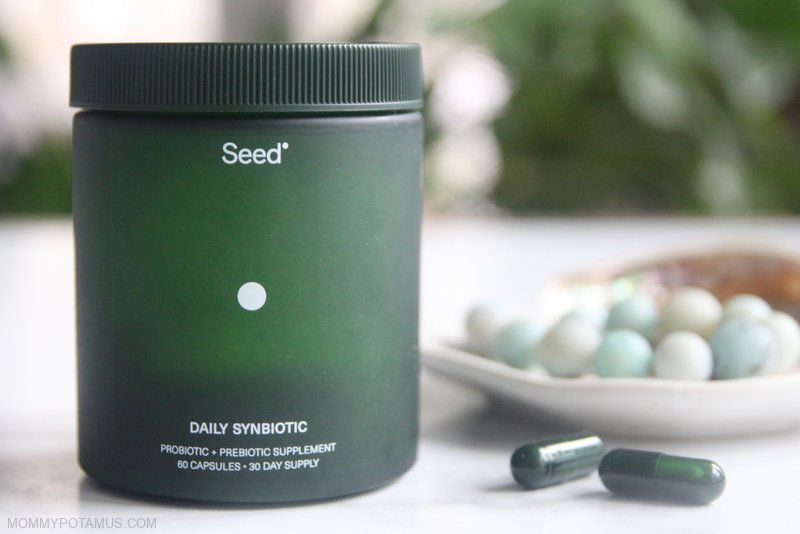
Which Probiotic I Use (And Why) ^
My husband and I both use Seed Synbiotic, which is a 2-in-1 prebiotic and probiotic. (Probiotic + Prebiotic = Synbiotic)
Here’s why Seed is my top choice:
- Transparency – Because strain matters, and so does potency, Seed publishes exactly what strains are included and uses the same dosage range that has been shown to deliver a benefit in human studies. Here’s what their blend includes:
- Digestive Health, Gastrointestinal Immunity & Gut Barrier Integrity Blend (17 research-backed strains)
- Dermatological Health Blend (5 research-backed strains)
- Cardiovascular Health Blend (3 research-backed strains)
- Micronutrient Synthesis Blend (2 research-backed strains)
- Microbiota-Accessible Prebiotic™ [MAP] Blend (prebiotics)
- Survivability – Seed uses nested capsules that are designed to survive the harsh environment of the stomach. Basically, there’s an inner capsule with beneficial bacteria that is nested inside an outer capsule filled with a powdered prebiotic made from pomegranate that shields the bacteria from oxygen, moisture, heat, and stomach acid.
- Allergen-Free – It’s free of common allergens like dairy, gluten, and soy.
- Seed’s Chief Scientist, Dr. Gregor Reid, is literally the guy who coined the word “probiotic.” – In addition, their Scientific Advisory Board is made up of scientists, researchers, doctors and authors across the fields of microbiology, immunology, genetics, metabolomics, gastroenterology, pediatrics, molecular biology, and transcriptomics. They lead labs, teach at world-renowned academic institutions, and have among them 2800+ publications and over 140,000 citations in peer-reviewed scientific journals and textbooks.
Because probiotics work best when taken regularly, Seed’s Daily Synbiotic is only available via a monthly subscription. However, if needed you can easily skip/reschedule a delivery or cancel if needed.
Want to try Seed’s Daily Synbiotic? ^
Click here and use MPSAVE15 for 15% off your first month.
Want more research-backed natural remedies?
No problem, I’ve created a free ebook for you – Kitchen Apothecary: 25+ Natural Remedies Using Ingredients From Your Pantry – as a gift for signing up for my newsletter. You’ll also get updates when I post about safe essential oils for pregnant/breastfeeding mamas, exclusive gifts and coupons (I was able to give away a jar of free coconut oil to anyone who wanted it recently!), plus other goodies.
Sign up using the form below.
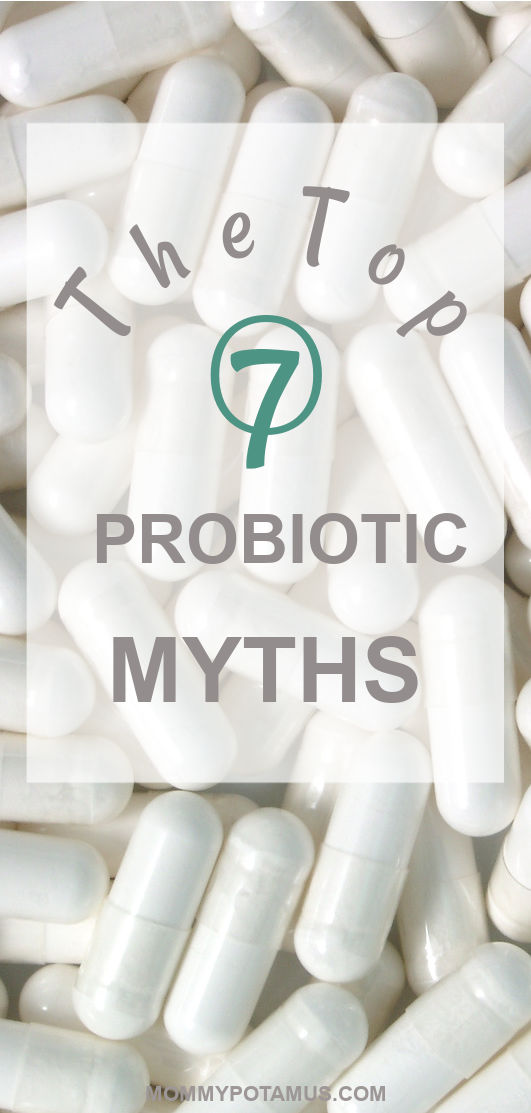
Sources
1. Nature Reviews: Microbiology (2011) Microbiology by numbers
2. Tompkins, TA et. al. (2011) The impact of meals on a probiotic during transit through a model of the human upper gastrointestinal tract
3. Anukam, Kingsley et. al. (2006) Augmentation of antimicrobial metronidazole therapy of bacterial vaginosis with oral probiotic Lactobacillus rhamnosus GR-1 and Lactobacillus reuteri RC-14
4. Song, Hyun Joo et. al. (2010) Effect of probiotic Lactobacillus (Lacidofil® Cap) for the prevention of antibiotic-associated diarrhoea: a prospective, randomised double-blind multicenter study
5. Marque Medical. How Probiotics Help While Taking Antibiotics

